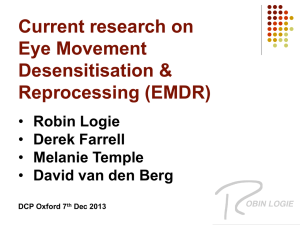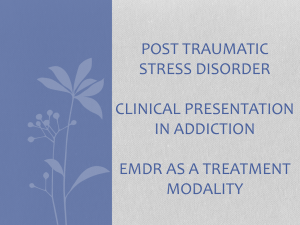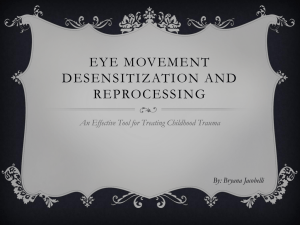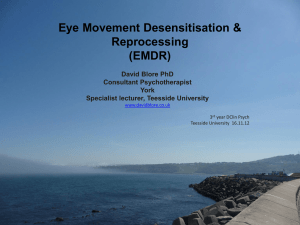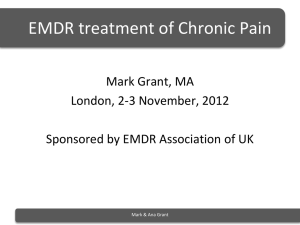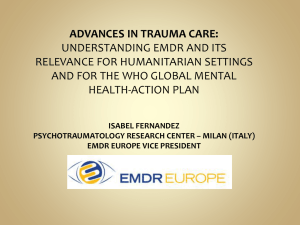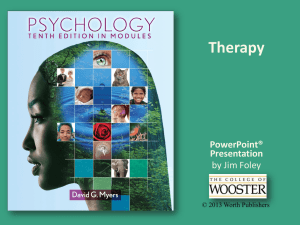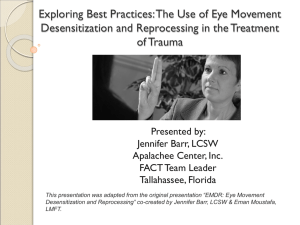VII EMDR and APPLIED KINESIOLOGY
advertisement
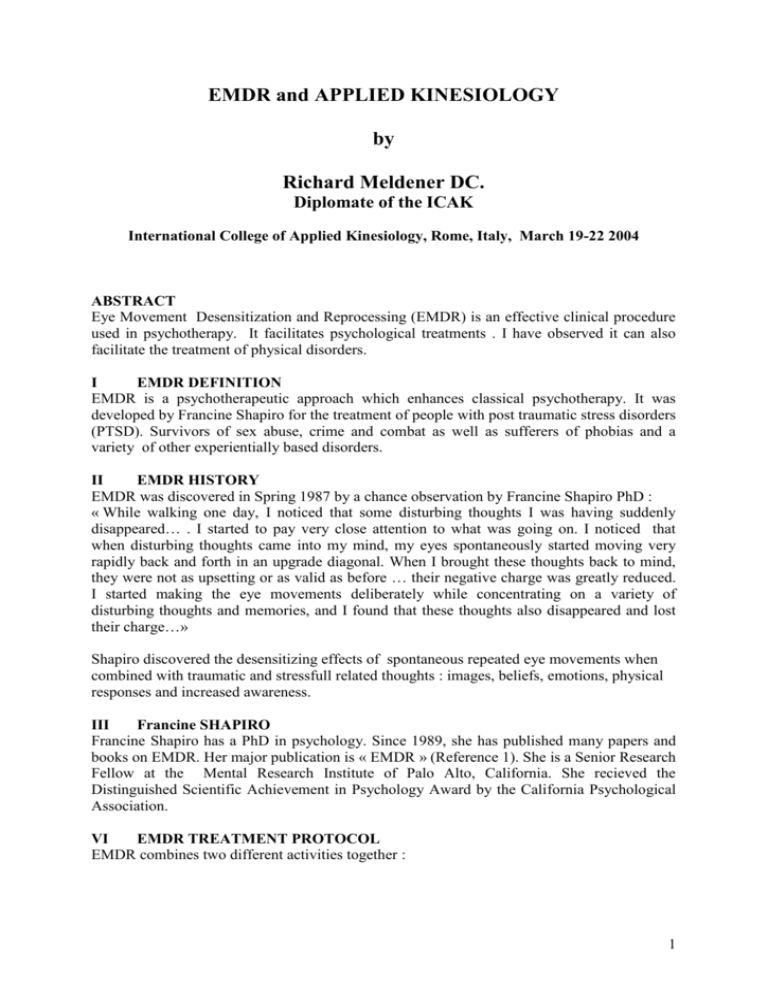
EMDR and APPLIED KINESIOLOGY by Richard Meldener DC. Diplomate of the ICAK International College of Applied Kinesiology, Rome, Italy, March 19-22 2004 ABSTRACT Eye Movement Desensitization and Reprocessing (EMDR) is an effective clinical procedure used in psychotherapy. It facilitates psychological treatments . I have observed it can also facilitate the treatment of physical disorders. I EMDR DEFINITION EMDR is a psychotherapeutic approach which enhances classical psychotherapy. It was developed by Francine Shapiro for the treatment of people with post traumatic stress disorders (PTSD). Survivors of sex abuse, crime and combat as well as sufferers of phobias and a variety of other experientially based disorders. II EMDR HISTORY EMDR was discovered in Spring 1987 by a chance observation by Francine Shapiro PhD : « While walking one day, I noticed that some disturbing thoughts I was having suddenly disappeared… . I started to pay very close attention to what was going on. I noticed that when disturbing thoughts came into my mind, my eyes spontaneously started moving very rapidly back and forth in an upgrade diagonal. When I brought these thoughts back to mind, they were not as upsetting or as valid as before … their negative charge was greatly reduced. I started making the eye movements deliberately while concentrating on a variety of disturbing thoughts and memories, and I found that these thoughts also disappeared and lost their charge…» Shapiro discovered the desensitizing effects of spontaneous repeated eye movements when combined with traumatic and stressfull related thoughts : images, beliefs, emotions, physical responses and increased awareness. III Francine SHAPIRO Francine Shapiro has a PhD in psychology. Since 1989, she has published many papers and books on EMDR. Her major publication is « EMDR » (Reference 1). She is a Senior Research Fellow at the Mental Research Institute of Palo Alto, California. She recieved the Distinguished Scientific Achievement in Psychology Award by the California Psychological Association. VI EMDR TREATMENT PROTOCOL EMDR combines two different activities together : 1 1/ Memorisation of the trauma : The patient is requested to think about the traumatic event . He/she concentrates on either the entire traumatic event, or on the most upsetting aspect of the trauma or on the various aspects of it. He/she enters into the memory of the trauma with each of his/her five senses. 2/ Eye movements As the patient thinks about the traumatic event, he/she is instructed to do side to side eye movements without head rotation. He/she is conducted in this eye exercise by watching the operator’s swinging fingers. The operator swings his/her fingers from the patient’s left to the patient’s right and vice versa. The operator’s swinging right hand and fingers should be 12 to 14 inches away from the patient’s face. This eye exercise starts slowly and speeds up to the maximum comfortable speed. This eye movement activity should not create any pain, dryness or anxiety. If it does, eye movement directions and/or speed are adapted to the patient’s convenience. For example the eye movement can be changed and go from lower left to upper right and from upper right to lower left. The first set of eye swings consists of 24 bidirectional movements. Sometimes up to 36 bidirectional movements are necessary to help the Post Traumatic Stress . IV EMDR THEORY : The information processing model In EMDR when the patient brings up the memory of the trauma this seems to establish a link between consciousness and the brain memory storage site. Shapiro advances the concept that PTSD are caused by disturbing information stored in the nervous system. She uses EMDR to produce an altered brain state to modify the behavior of the information processing system. Neurobiological investigators still have not provided a definitive explanation for EMDR. A number of physiological studies are being carried out and theoretical suggestions have been put forth to link the effect of EMDR to REM sleep, dual attention and/or bihemispheric activity. V CONTROLLED STUDIES Various publications have validated the efficiency of EMDR both in civilian studies (Reference 2 to 15) and in studies of combat veterans (Reference 16 to 23). VII EMDR and APPLIED KINESIOLOGY A/ MY WORKING HYPOTHESIS My working hypothesis has been : if EMDR facilitates psychotherapy. EMDR should also facilitate the treatment of physical disorders and be approached using Applied Kinesiology (AK). B/ EMDR and APPLIED KINESIOLOGY Instead of combining psychotherapy and eye movement, I have combined : Stimulation of the physical disorders and eye movements as introduced by Shapiro. For example if a patient complains about his right knee following a ski accident, I treat the right knee as usual. I then apply the EMDR procedure. I have the patient stimulate his/her injured right knee and combine the knee stimulation with eye movement as discussed paragraph V/2. Stimulation of the knee can be done either by tapping it, or moving it or Therapy Localizing it, or even better, all 3 stimulations together.. Another example would be a patient complaining about digestive disorders . First I treat his gut as usual. Then I have him/her stimulate the gut by either therapy localization to the gut or to some gut-related reflex such as a neurolymphatic reflex or by ingestion of food known to stress the gut. This gut stimulation is combined with eye movements discussed paragraph V/2. 2 I have observed manual muscle testing normalisation after using this protocol as well as elimination of acute neurolymphatic reflex pain . C/ WHEN DO I USE EMDR ? I have used it in the following sequence : 1/ Usual treatment first 2/ Pain control if necessary 3/ EMDR I have sometimes used EMDR on the emotional side of traumas as Shapiro recommends : eye movements + discussion of various facets of the trauma. I have done this only in situations that are easy to handle. In deep psychological and emotional Post Traumatic Stress Disorders, I stay away from discussing the issue which I might not be able to handle. CONCLUSION The efficiency of EMDR on emotional disorders has been demonstrated and validated by numerous authors. I have adapted EMDR and applied it to physical disorders. I have found EMDR to speed up recovery time and prevent the discorder from recurring. DISCUSSION I have only used 24 bidirectional eye movements (sometimes up to 36) EMDR procedure once or twice per physical discorder treated. I have not used Dr Shapiro’s routine. It consists of repeating multiple 24 bidirectional eye mouvements. This is done while discussing multiple aspects of trauma-related disturbing thoughts and memories. BIBLIOGRAPHY 1. EMDR, Eye Movements Desensitization and Reprocessing, Basic Principles, Protocols and Procedures, 2001, Guilford Press, NY, www.guilford.com. Civilian studies 2. Chemtob, Nakashima, Hamada, and Carlson. 2002. Brief treatment for elementary school children with disaster related PTSD. A field study, Journal of Clinical Psychology, 58, 99-112 3. Devilly and Spence, 1999. The relative efficacy and treatment distress of EMDR and a cognitive behavioral trauma treatment protocol in the amelioration of posttraumatic stress discorder . Journal of Anxiety Disorders, 13,131-157 4. Edmond, Rubin, and Wambach, 1999. The effectiveness of EMDR with adult female survivors of childhood sex abuse , Social Work Research, 23, 103-116 5. Ironson, Freund, Strauss, and Williams, 2002, A comparison of two treatments for traumatic stress : A community based study of EMDR and prolonged exposure, Journal of Clinical Psychology, 58,113-128 6. Lee, Gavriel, Drummond, Richards, and Greenwald. In press. Treatment of Post Traumatic Stress Disorder : A comparison of stress inoculation training with prolonged exposure and eye movement desensitization and reprocessing. Journal of Clinical Psychology 7. Marcus, Marquis, and Sakai, 1997, Controlled study of treatment of PTSD using EMDR in an HMO setting, Psychotherapy, 34, 307-315 8. Renfrey, and Spates, 1994, Eye movement desensitization and reprocessing : A partial dismantling procedure. Journal of Behavior Therapy and Experimental Psychiatry, 25, 231-239 3 9. Rothbaum, 1997, A controlled study of eye movement desensitization and reprocessing for posttraumatic stress discorder sexual assault victims. Bulletin of the Menninger Clinic, 61, 317-334 10. Scheck, Schaeffer, and Gillette, 1998, Brief psychological intervention with traumatized young women : The efficacy of eye movement desensitization and reprocessing, Journal of Traumatic Stress, 11, 25-44 11. Shapiro 1989, Efficacy of eye movement desensitization procedure in the treatment of traumatic memories. Journal of Traumatic Stress Studies, 2, 199-223 12. Vaughan, Armstrong, Gold, O’Connor, Jenneke, and Tarrier 1994, A trial of eye movement desensitization compared to image habituation training and applied muscle relaxation in post traumatic stress discorder, Journal of Behavior Therapy and Experimental Psychiatry, 25, 283-291 13. D. Wilson, Silver Covi, and Foster, 1996, Eye movement desensitization and reprocessing : Effectiveness and autonomic correlates, Journal of Behavioral Therapy and Experimental Psychiatry, 27, 219-229 14. S. Wilson, Becker, and Linker, 1995, Eye movement desensitization and reprocessing (EMDR) treatment for psychologically traumatized individuals, Journal of Consulting and Clinical Psychology, 63, 928-937 15. S. Wilson, Becker, and Linker, 1997, Fifteen month follow-up of eye movement desensitization and reprocessing (EMDR) treatment for PTSD and psychological trauma. Journal of Consulting and Clinical Psychology, 65, 1047-1056 Studies of Combat Veterans 16. Boudewyns, Stwertka, Hyer, Albrecht, and Sperr, 1993, Eye movements desensitization and reprocessing : A pilot study. Behavior Therapy, 16, 30-33 17. Boudewyns and Hyer, 1996, Eye movement desensitization and reprocessing (EMDR) as treatment for post-traumatic stress discorder (PTSD) Clinical Psychology and Psychotherapy, 3, 185-195 18. Carlson, Chemtob, Rusnak, Hedlund, and Muroaka. 1998. Eye movement desensitization and reprocessing for combat-related posttraumatic stress discorder. Journal of Traumatic Stress, 11, 3-24 19. Devilly, Spence and Rapee. 1998. Statistical and reliable change with eye movement desensitization and reprocessing : Treating trauma with veteran population. Behavior Therapy, 29, 435-455 20. Jensen. 1994. An investigation of eye movement desensitization and reproduction (EMD/R) as a treatment for posttraumatic stress discorder (PTSD) symptoms of Vietnam combat veterans. Behavior Therapy, 23, 311-326 21. Pitman, Orr, Altman, Longpre, Poire, and Macklin. 1996. Emotional processing during eye movement desensitization and reproduction therapy of Vietnam veterans with chronique post traumatic stress disorders, Comprehensive Psychiatry, 37 , 419429 22. Rogers, Silver, Goss, Oberchain, Willis, and Whitney.1999.A single session , controlled group study of flooding and eye movement desensitization and reprocessing in treating posttraumatic stress discorder among Vietnam war veterans : Preliminary data, Journal of Anxiety Disorders, 13,119-130 4

